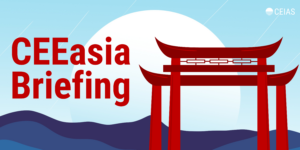This policy paper by CEIAS researchers aims to explore the possibilities of the multilateral approach towards China within the V4 (V4+China). The first chapter presents an overview of the trade and investment relationship between the V4 countries and China. In the second chapter, we discuss the form and achievements of the V4+Japan and V4+South Korea cooperation platforms. Finally, in the third chapter we provide four specific proposals on how V4+China can become a meaningful tool for the V4 countries to improve their relations with China.
Summary
- Due to its size and limited development of bilateral ties with China, Slovakia and to some extent also other V4 countries rely mainly on multilateral platforms in their dealings with China.
- The CEE countries have failed to leverage the 16/17+1 platform (also known as China-CEE Cooperation) to produce benefits from their diplomatic engagement with China. The V4+China format presents a potential alternative for the V4 countries to coordinate their China policies.
- The V4 countries run long-term large trade deficits with China. These deficits are of structural nature due to the integration of the V4 countries in international supply chains, when much of V4 products are re-exported to China via Germany. As a result, the official bilateral trade statistics do not show the whole picture of the V4-China trade links.
- Chinese investments in the V4 remain small and are dominated by a few larger acquisitions. This is not in line with the V4 countries’ preferences for greenfield investment.
- In both trade and investment matters, a deeper cooperation and coordination among the V4 countries and Germany is needed, as the dynamics of economic ties go far beyond bilateral relationships of the individual V4 countries with China.
- The V4+Japan and V4+South Korea provide a potential model for V4+China cooperation as the most developed forms of cooperation between the V4 and Asian countries.
- The V4+Japan format is relatively mature, based on intensive, multi-sectoral and multi-level contacts. V4+South Korea has seen more limited but focused cooperation.
- Both formats are explicitly based on the shared values and adherence to international norms, the foundation that is lacking with China.
- Global governance and international security issues have been a mainstay of the cooperation with Japan and South Korea, with both sides seeking diplomatic support for their priorities. The agenda has been complemented by cooperation in innovation, energy, infrastructure, support for SME, culture, and tourism.
- While political cooperation has been mostly seamless, the failure to issue a common statement after the 2018 V4+Japan summit might point to the growing diplomatic clout of China in the V4 countries.
- V4 countries have managed to enlist support from Japan and South Korea for development projects in the priority regions of Western Balkans and Eastern Partnership This has become an outward dimension of cooperation within the V4+ formats.
Recommendations for policymakers
Turn the V4 into a force in China-EU relations
- The V4 countries should take advantage of their EU membership and use it as a leverage in ties with China. At the same time, the V4 countries need to be wary of becoming China’s “trojan horses” within the EU which could negatively affect their overall standing in the EU politics.
- V4 should become an active actor in formulating the common EU China-policy. The aim should be a greater alignment of the EU policy with the V4 economic and political interests.
- The V4 countries’ trade engagement with China is highly dependent on Sino-German economic ties as the majority of the exposure to China comes in form of re-exports of V4 products through Germany. Therefore, the V4 members should coordinate their trade and broader economic policies among themselves as well as with Germany.
Use the V4+China platform as a vehicle for pragmatic cooperation
- The V4+China platform should be actively developed by the V4 countries in order to spearhead a focused, practical cooperation in various areas, including research, education, trade and investment promotion, cultural exchanges and cooperation on external development assistance projects.
- Politicization of the V4+China cooperation should be avoided. The EU should remain the crucial forum for multilateral engagement with China.
- V4 countries should look back at successful examples of the V4+Japan and V4+South Korea cooperation as models for V4+China ties.
- V4 could aim at making cooperation on Western Balkans the external dimension of V4+China. This should help to better align Chinese activities in the Western Balkans with the overall EU objectives in the region and thus help mitigate the negative effects Chinese activities might have on the region.
Cooperate on the ground
- The V4 embassies, consulates, and other state agencies in China should improve their communication and coordinate their activities.
- As V4 consists mostly of smaller states (with the exception of Poland), they should pool their resources in order to maximize the efficiency of their use.
- The V4 should work together to increase brand awareness of “Central Europe” in China.
- The V4 should closely cooperate on practical issues of V4+China cooperation such as tourism, trade, investment, and culture.
Empower the Slovak China policy
- Slovakia should increase its diplomatic representation in China. This increase should have both personal and spatial aspects.
- Slovak representation should be reinforced by more diplomatic staff, including specialized economic diplomats.
- Slovakia should consider revising its consular map in China and open new consulates in other parts of the country – e. g. in Shenzhen, Chengdu, or Chongqing – which would improve the reach of Slovak diplomacy beyond Beijing and Shanghai
- Due to limited resources, Slovakia needs to identify priority areas for its relationship with China based on a rigorous and data-based cost-benefit analysis.
- Slovakia needs to come up with a coherent China-strategy which will contain clear and measurable objectives and specify the means to achieve these objectives. Such a strategy should be aware of both the economic and political realities of China, including its human rights track record. Moreover, the specific China-strategy should be set within a wider Asia-Pacific strategy.






